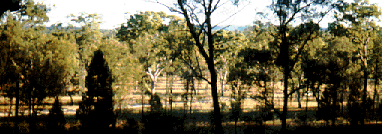 Much of the park area is
open woodland on broad undulating hills.
Much of the park area is
open woodland on broad undulating hills.

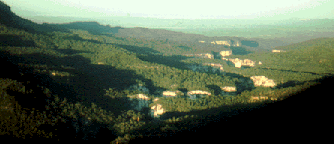 Carnarvon National Park is a 10-hour bus trip from Brisbane. Weathering
over millions of years has molded the landscape of the relatively isolated
Mt. Moffat section of this central Queensland park and the 20,000 acres of
the adjacent Saddler Springs Education Center.
Carnarvon National Park is a 10-hour bus trip from Brisbane. Weathering
over millions of years has molded the landscape of the relatively isolated
Mt. Moffat section of this central Queensland park and the 20,000 acres of
the adjacent Saddler Springs Education Center.
Carnarvon Gorge in the late afternoon from the lookout at Battleship Spur.
 Much of the park area is
open woodland on broad undulating hills.
Much of the park area is
open woodland on broad undulating hills.
The Saddler Springs Education Center where we stayed is a remote cattle property located between Carnarvon Gorge and Mt Moffat National Parks. It is part of a tangle of weathered cliffs, gorges, spurs, and springs... rugged, unspoiled country that contains the spirit of an earlier Australia.
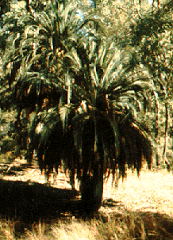
Division: Cycadophyta Class: Cycadopsida Order: Cycadales Family: Cycadaceae Species: Macrozamia mooreiIn and around the Education Center, cycads were common in the grassy understorey. This ancient plant is the symbol for the center. According to information from the Australian National Botanic Gardens, the Aboriginal peoples of Australia used this plant as a food source. "The seeds of these and other cycads are borne in a large cone and have an orange outer coat. They are poisonous, but the Aborigines knew how to treat them to remove the poison, and so take advantage of the large amount of food provided by a single plant. One of the ways was to cook the seed, break it up, and then soak it for up to three weeks in running water. In Western Australia, only the outer red part was eaten, after treatment by washing and burying." See Albion College Bio 216: Vascular Plants for additional information.
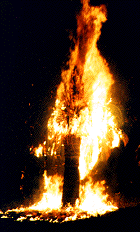 Macrozamia are fire tolerant. In this region they have to be as graziers periodically
burn off the land to increase the growth of native grasses for cattle.
Although they seem to contain oils and resins which
make them burn rapidly and dramatically as shown here, the trunk and roots remain viable and the plant leafs out
again in a matter of months.
Macrozamia are fire tolerant. In this region they have to be as graziers periodically
burn off the land to increase the growth of native grasses for cattle.
Although they seem to contain oils and resins which
make them burn rapidly and dramatically as shown here, the trunk and roots remain viable and the plant leafs out
again in a matter of months.
Aboriginal peoples also burned the land periodically. In part, they, too, wanted
to increase the growth of native grasses so that kangaroos and other game would
be available.
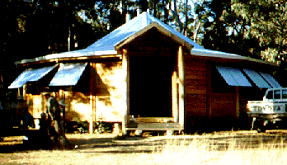 Junjuddie Flat is the outstation at Saddler Springs which consists of
a dining hall (shown) with a wood stove and fireplace, four large slab
huts for sleeping, a washroom with two wood-fired hot showers, and a two-hole
outhouse. There's no electricity available. Students were not allowed to use radios,
tape players, etc. while there. We all helped with meal preparation and
clean-up.
Junjuddie Flat is the outstation at Saddler Springs which consists of
a dining hall (shown) with a wood stove and fireplace, four large slab
huts for sleeping, a washroom with two wood-fired hot showers, and a two-hole
outhouse. There's no electricity available. Students were not allowed to use radios,
tape players, etc. while there. We all helped with meal preparation and
clean-up.
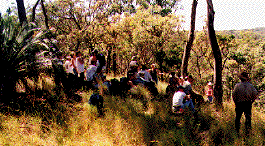 The morning after our arrival, we hiked up the headwaters of the Merivale River
to the top of the Carnarvon Ranges. Along the way, Lloyd Hancock gave an introduction
to the history of this region.
The morning after our arrival, we hiked up the headwaters of the Merivale River
to the top of the Carnarvon Ranges. Along the way, Lloyd Hancock gave an introduction
to the history of this region.
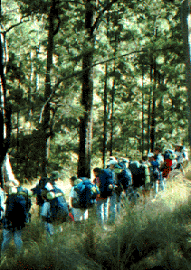
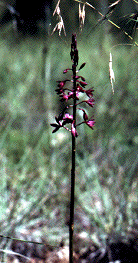
The themes for the walk were: local ecology and geology, bush tucker,
introduction to the aboriginal use of the surrounding area, and the early
European use of the land. The hike featured short but strenuous uphill and
downhill segments.
A hyacinth orchid along the trial to Battleship Spur.
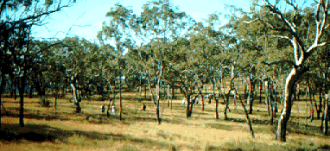 The afternoon return hike from Battleship Spur took us through the low bush country
that is typically used for cattle grazing in this part of Australia.
This was the program's only
visit to an arid ecosystem, by far the most common in Australia.
The afternoon return hike from Battleship Spur took us through the low bush country
that is typically used for cattle grazing in this part of Australia.
This was the program's only
visit to an arid ecosystem, by far the most common in Australia.
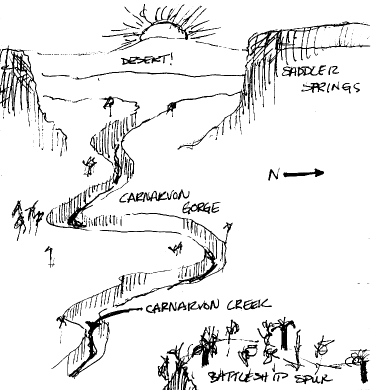 Sketch of Carnarvon Gorge from Battleship Spur by S. Flanders '98.
Sketch of Carnarvon Gorge from Battleship Spur by S. Flanders '98.
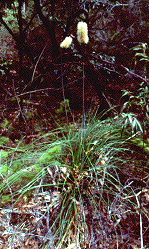
Family: Xanthorrhoeaceae Species: Xanthorrhoea spp. "Grass Trees"
Grass trees were encountered at Lamington,
Stradbroke Island, and Carnarvon Gorge.
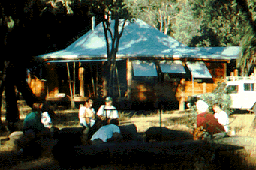 A warm shower and fire at the base camp provided welcome relief after the
hike to Battleship Spur and back.
A warm shower and fire at the base camp provided welcome relief after the
hike to Battleship Spur and back.
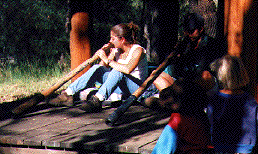 Several students learned to play the digeridoo while in Brisbane and
brought their instruments on this trip.
The sounds of the digeridoos in the background late in the afternoon
transported us back in time thousands of years.
Several students learned to play the digeridoo while in Brisbane and
brought their instruments on this trip.
The sounds of the digeridoos in the background late in the afternoon
transported us back in time thousands of years.
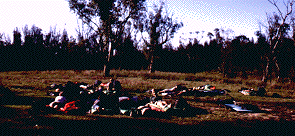 For two days and one night we stayed in the Mt Moffat section of Carnarvon
National Park. We set up camp under the stars and cooked over a campfire.
For two days and one night we stayed in the Mt Moffat section of Carnarvon
National Park. We set up camp under the stars and cooked over a campfire.
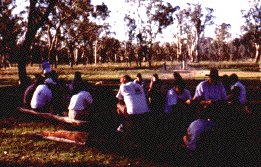 Clear skies, and warm temperatures, the late afternoon sun, and conversation
around the fire brought the day to a relaxing close. The Dragonelly Rock Hole campsite
was near a creek that was an important water source of for Aboriginal peoples.
Gavin discussed the processes that they had perfected
to manufacture stone tools in this region.
Clear skies, and warm temperatures, the late afternoon sun, and conversation
around the fire brought the day to a relaxing close. The Dragonelly Rock Hole campsite
was near a creek that was an important water source of for Aboriginal peoples.
Gavin discussed the processes that they had perfected
to manufacture stone tools in this region.
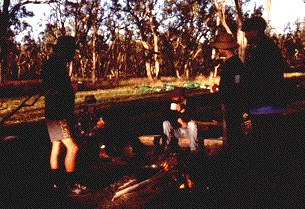 With sunrise, We got the "billy" going to make tea for the
earlier risers.
With sunrise, We got the "billy" going to make tea for the
earlier risers.
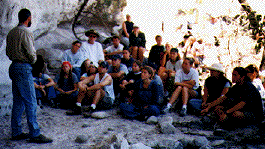 While a the Mt Moffat section of the park, Ranger Gavin Enevra, who had helped
out with the 1994 program, again spent many hours
with us. Here at Marlong Arch, he explains the human pressures put on many remote
parks which do not have sufficient funds to protect and preserve all of the
fragile aboriginal art and burial sites. His budget: under $20,000 to manage
an area half the size of the State of Rhode Island.
While a the Mt Moffat section of the park, Ranger Gavin Enevra, who had helped
out with the 1994 program, again spent many hours
with us. Here at Marlong Arch, he explains the human pressures put on many remote
parks which do not have sufficient funds to protect and preserve all of the
fragile aboriginal art and burial sites. His budget: under $20,000 to manage
an area half the size of the State of Rhode Island.
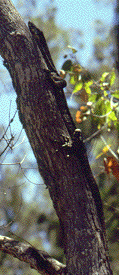
Class: Reptilia Order: Squamata Species: Varanus varius "Lace Monitor" or "Mountain Dragon"Body length 55 cm, tail length 140 cm. Lace monitors were the largest lizards we saw in Australia. They are common to woodlands and forest peripheries. Near picnic grounds, they patrol for scraps. This individual, was seen near Junjuddie Flats, the dining hall at Saddler Springs.
One student noticed that it "waddles" because of its relatively high hip location. (Sketch by S. Flanders '98)

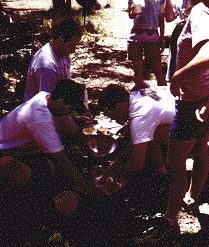 On the last afternoon of the trip, students participated in several
different activities ranging from making damper over the campfire....
... to collecting honey (and a few stings)
from some hives that had been neglected for a number of years, to helping
with the day's "school of the air" broadcast. With town over 100 km away,
the Hancock children "go" to
school by radio. They are linked by interactive radio
with teachers and other students in this area.
On the last afternoon of the trip, students participated in several
different activities ranging from making damper over the campfire....
... to collecting honey (and a few stings)
from some hives that had been neglected for a number of years, to helping
with the day's "school of the air" broadcast. With town over 100 km away,
the Hancock children "go" to
school by radio. They are linked by interactive radio
with teachers and other students in this area.
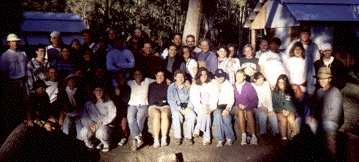
The students got to know Lloyd Hancock (Director of Saddler Springs and a grazier), his wife Jackie and their children, and his assistants Carolyn Roberts, Puddy Chandler, and Kate Wilson very well. They obtained a glimpse of what it is like to live in the outback where children are educated by radio and the nearest town is 90 km of dirt road away.
 At Saddler Springs and Mt. Moffat, students were able to experience a part
of Australia that even few Australians visit. An article in The
Courier-Mail described Carnarvon this way:
At Saddler Springs and Mt. Moffat, students were able to experience a part
of Australia that even few Australians visit. An article in The
Courier-Mail described Carnarvon this way:
But I will tell you more.... about the natural castles of Queensland which nature has painstakingly constructed over many thousands of years, the grand castles, fortresses and cathedrals of the Carnarvon Gorge.
The thing that struck me walking into Carnarvon for the first time recently was what sort of dill was I to have ignored the place for almost 60 years when I've lived within a long day's drive of it most of my life.
But I am not alone in my ignorance
of the Carnarvons because most
Queenslanders have never been there,
even many of those living on its
doorstep in the Central Highlands.
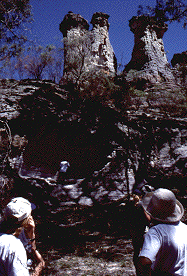 At places such as "Cathedral Rock" and "The Chimneys" (shown here), Lloyd Hancock
discussed
the great rites of initiation and burial for the
Murgin and Bidjara, the local aboriginal peoples. Later, around the campfire
Lloyd with Gavin Enevra, discussed the death of the local traditional culture
on Queensland pastoral frontier.
Bark of the budgeroo tree contains a natural preservative and was used by the
indigenous peoples as an inner sleeve for their burial cylinders.
At places such as "Cathedral Rock" and "The Chimneys" (shown here), Lloyd Hancock
discussed
the great rites of initiation and burial for the
Murgin and Bidjara, the local aboriginal peoples. Later, around the campfire
Lloyd with Gavin Enevra, discussed the death of the local traditional culture
on Queensland pastoral frontier.
Bark of the budgeroo tree contains a natural preservative and was used by the
indigenous peoples as an inner sleeve for their burial cylinders.
Current attitudes towards and the
difficulties of recent aboriginal land claims were also touched upon, as well
as the role of national parks.
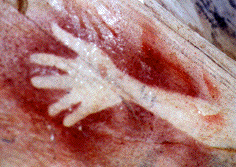 The Tombs are a basaltic covered outcropping of sandstone. The basalt has
protected the sandstone from weathering. For the Aborigines, this site had
an important spiritual aspect serving as both an initiation and a burial
site. It contains fine examples of Aboriginal stencil art done in red (hematite),
yellow (limonite), and white ochres. This special ochre was carried more than 1000
miles by the Aborigines from a site in south Australia. This helped put our
bush walk in perspective.
The Tombs are a basaltic covered outcropping of sandstone. The basalt has
protected the sandstone from weathering. For the Aborigines, this site had
an important spiritual aspect serving as both an initiation and a burial
site. It contains fine examples of Aboriginal stencil art done in red (hematite),
yellow (limonite), and white ochres. This special ochre was carried more than 1000
miles by the Aborigines from a site in south Australia. This helped put our
bush walk in perspective.
An example of the many red ochre stencils of hands seen at "The Tombs".
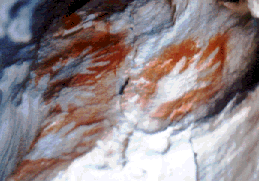 A left
hand indicates that the individual has "received" something (often spiritual)
at the site, while a right hand indicates that an offering has been made.
A left
hand indicates that the individual has "received" something (often spiritual)
at the site, while a right hand indicates that an offering has been made.
 The design of this stenciled boomerang indicates that it was used for hunting.
The design of this stenciled boomerang indicates that it was used for hunting.
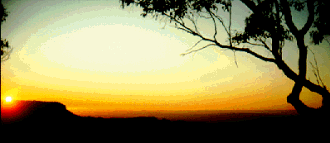 From a Journal:
From a Journal: